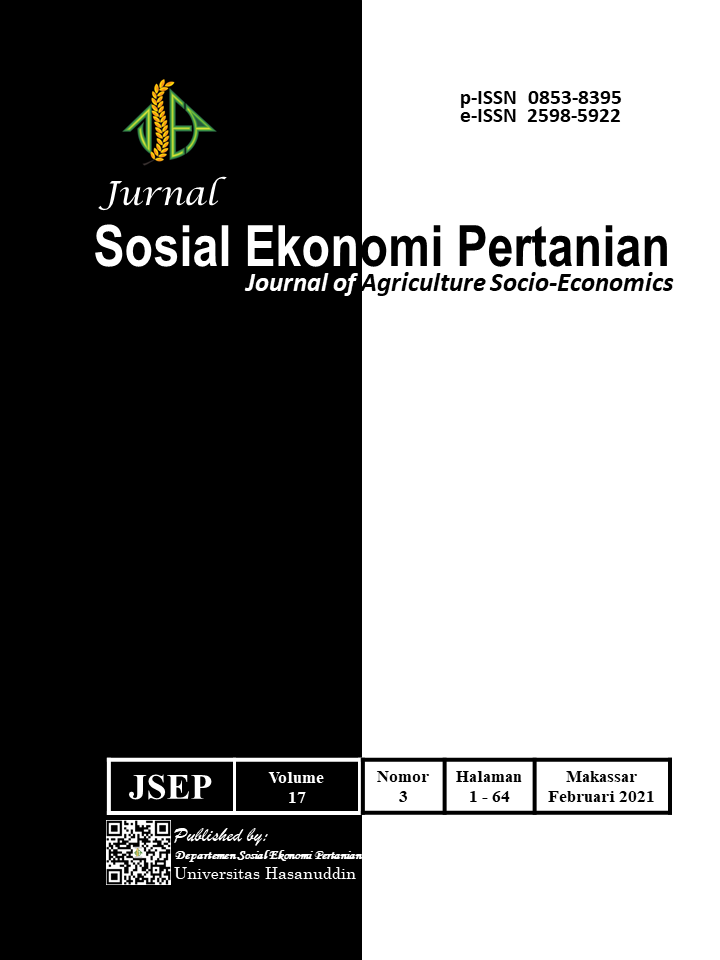Dampak Kebijakan Billing System Penebusan Pupuk Subsidi di Provinsi Lampung
Isi Artikel Utama
Abstrak
Billing System Penebusan Pupuk dapat dianggap sebagai kebijakan dan/atau terobosan baru dalam sistem distribusi pupuk subsidi di Provinsi Lampung. Walaupun mempunyai potensi untuk mengatasi permasalahan penyaluran pupuk subsidi, dampak aktual kebijakan tersebut belum dikaji secara ilmiah, terutama di tingkat petani. Penelitian ini bertujuan untuk menjawab pertanyaan-pertanyaan (1) bagaimanakah dampak Kebijakan Billing System pada kuantitas penggunaan dan harga pupuk subsidi di tingkat petani? dan (2) bagaimanakah dampak Kebijakan Billing System pada produksi padi petani? Penelitian dilakukan pada bulan Juni 2020 sampai dengan Februari 2021. Total responden berjumlah 314 orang petani padi yang disurvei secara acak sistematis di Kabupaten Lampung Timur, Kabupaten Lampung Selatan, dan di Kota Metro. Evaluasi dampak dilakukan dengan teknik Propensity Score Matching (PSM) yaitu metode kuantitatif yang kredibel untuk mengoreksi bias seleksi dan bias variabel-variabel lainnya. Hasil penelitian menunjukkan bahwa Billing System secara signifikan meningkatkan penggunaan rata-rata Pupuk Urea dan menurunkan harga rata-rata harga Pupuk Urea dan SP36 di tingkat kelompok tani. Namun, Billing System belum berdampak signifikan pada rata-rata produksi padi petani. Salah satu implikasi temuan penelitian adalah Billing System memiliki berpotensi mengatasi masalah distribusi pupuk subsidi di Lampung, namun peningkatan kapasitas kelembagaan petani masih sangat diperlukan.
Rincian Artikel

Artikel ini berlisensi Creative Commons Attribution-NonCommercial 4.0 International License.
This works is under Creative Commons Attribution LicenseReferensi
Badan Pusat Statistik. (2020). Luas panen dan produksi padi di Indonesia 2019: Vol. XXIII (Issue 16). https://www.bps.go.id/pressrelease/download.html?nrbvfeve=MTc1Mg%3D%3D&sdfs=ldjfdifsdjkfahi&twoadfnoarfeauf=MjAyMC0wMi0yNSAxMzoyNjozMg%3D%3D
Blackman, A., & Rivera, J. (2011). Producer‐level benefits of sustainability certification. Conservation Biology, 25(6), 1176–1185.
Ferraro, P. J. (2009). Counterfactual thinking and impact evaluation in environmental policy. New Directions for Evaluation, 2009(122), 75–84.
Frondel, M., & Schmidt, C. M. (2005). Evaluating environmental programs: The perspective of modern evaluation research. Ecological Economics, 55(4), 515–526.
Greenstone, M., & Gayer, T. (2009). Quasi-experimental and experimental approaches to environmental economics. Journal of Environmental Economics and Management, 57(1), 21–44.
Indriasari, D. P., & Sani, A. (2019). Pengendalian Manajemen Pupuk Subsidi. Jurnal Aplikasi Manajemen & Kewirausahaan MASSARO, 1(1).
Kementerian Pertanian. (2018a). Peraturan Menteri Pertanian Republik Indonesia Nomor47/permentan/SR.310/11/2018 tentang alokasi dan haga eceran tertinggi pupuk bersubsidi sektor pertanian tahun anggaran 2019.
Kementerian Pertanian. (2018b). Statistik pertanian 2017. http://epublikasi.setjen.pertanian.go.id/epublikasi/StatistikPertanian/2017/Statistik Sarana Pertanian Tahun 2017/files/assets/basic-html/page2.html
Khandker, S., B. Koolwal, G., & Samad, H. (2009). Handbook on impact evaluation: quantitative methods and practices. The World Bank.
Komisi Pemberantasan Korupsi. (2017). Kajian kebijakan subsidi di bidang pertanian.
Lasindrang, R. Z. Y., & Fauzi DH, A. (2018). Hubungan distribusi terhadap penjualan (Studi Pada Distribusi Pupuk Npk Non Subsidi Area Pemasaran Kalimantan Di Pt. Pupuk Kalimantan Timur). Jurnal Administrasi Bisnis, 54(1), 197–206.
Legan, D., & Vandeven, M. H. (2003). Sampling techniques. In Detecting Pathogens in Food. John Wiley & Sons. https://doi.org/10.1016/B978-1-85573-670-2.50007-5
Mead, R. (2017). Statistical methods in agriculture and experimental biology. Chapman and Hall/CRC.
Peraturan Gubernur Lampung. (2016). Peraturan Gubernur Lampung Nomor 99 tahun 2016 tentang pola distribusi pupuk bersubsidi di sektor pertanian di Provinsi Lampung.
Ruben, R., & Fort, R. (2012). The impact of fair trade certification for coffee farmers in Peru. World Development, 40(3), 570–582.
Ruben, R., & Zuniga, G. (2011). How standards compete: comparative impact of coffee certification schemes in Northern Nicaragua. Supply Chain Management: An International Journal, 16(2), 98–109.
Sari, L. R., & Fahmi, A. (2018). Dampak subsidi pupuk terhadap peningkatan pendapatan dan kesejahteraan petani kecamatan megaluh jombang dalam perspektif fenomenologis. MARGIN ECO, 2(2), 86–101.
Stata Corp. (2018). Selection Model Heckoprobit. http://www.stata.com/Manuals14/Svysvyestimation.Pdf.
Sukmayanto, M., Alviana, E. D., & Muhtholib, A. (2019). Persepsi petani padi terhadap program billing sistem di kecamatan metro barat kota metro. Mimbar Agribisnis: Jurnal Pemikiran Masyarakat Ilmiah Berwawasan Agribisnis, 5(1), 114–123.
Suryana, A., Agustian, A., & Yofa, R. D. (2018). Alternatif kebijakan penyaluran subsidi pupuk bagi petani pangan. Analisis Kebijakan Pertanian, 14(1), 35–54.
Susilowati, S. H. (2018). Urgensi dan Opsi Perubahan Kebijakan Subsidi Pupuk. Analisis Kebijakan Pertanian, 14(2), 163–185.
White, H. (2006). Impact evaluation: the experience of the Independent Evaluation Group of the World Bank. Independent Evaluation Group, the World Bank.
Zakaria, W. A., Ibnu, M., Marlina, L., & Endaryanto, T. (2018). Evaluasi KinerjaKebijakan Billing Sistem Penebusan Pupuk Subsidi Dalam Rangka Mencapai Target Swasembada Pangan di Provinsi Lampung.
Zulaiha, A. R., Nurmalina, R., & Sanim, B. (2018). Kinerja Subsidi Pupuk di Indonesia. Jurnal Aplikasi Bisnis Dan Manajemen (JABM), 4(2), 271.

